Subseasonal Variation Characteristics of Low-Cloud Fraction in Southeastern and Northwestern North Pacific
Abstract
:1. Introduction
2. Data and Methods
2.1. Reanalysis Data
2.2. Satellite Data
2.3. Calculated Data
2.4. Methods
3. Results
3.1. Subseasonal Variation of LCF
3.2. Association with Meteorological Parameters
3.3. Lead-Lag Relationship
4. Conclusions and Discussion
Author Contributions
Funding
Institutional Review Board Statement
Informed Consent Statement
Data Availability Statement
Conflicts of Interest
References
- Wood, R. Stratocumulus Clouds. Mon. Weather Rev. 2012, 140, 2373–2423. [Google Scholar] [CrossRef]
- Garrett, T.J.; Zhao, C. Increased Arctic cloud longwave emissivity associated with pollution from mid-latitudes. Nature 2006, 440, 787–789. [Google Scholar] [CrossRef] [PubMed]
- Xie, S.P. The Shape of Continents, Air-Sea Interaction, and the Rising Branch of the Hadley Circulation. In The Hadley Circulation: Present, Past and Future; Springer: Dordrecht, The Netherlands, 2004. [Google Scholar] [CrossRef]
- Oreopoulos, L.; Davies, R. Statistical dependence of albedo and cloud cover on sea surface temperature for two tropical marine stratocumulus regions. J. Clim. 1993, 6, 2434–2447. [Google Scholar] [CrossRef]
- Ma, Z.; Liu, Q.; Zhao, C.; Shen, X.; Wang, Y.; Jiang, J.H.; Li, Z.; Yung, Y. Application and Evaluation of an Explicit Prognostic Cloud-Cover Scheme in GRAPES Global Forecast System. J. Adv. Model. Earth Syst. 2018, 10, 652–667. [Google Scholar] [CrossRef]
- Grise, K.M.; Polvani, L.M.; Fasullo, J.T. Re-examining the relationship between climate sensitivity and the southern hemisphere radiation budget in CMIP models. J. Clim. 2015, 28, 9298–9312. [Google Scholar] [CrossRef]
- Koshiro, T.; Yukimoto, S.; Shiotani, M. Interannual variability in low stratiform cloud amount over the summertime North Pacific in terms of cloud types. J. Clim. 2017, 30, 6107–6121. [Google Scholar] [CrossRef]
- Klein, S.A.; Hartmann, D.L. The Seasonal Cycle of Low Stratiform Clouds. J. Clim. 1993, 6, 1587–1606. [Google Scholar] [CrossRef]
- Weare, B.C. Near-global observations of low clouds. J. Clim. 2000, 13, 1255–1268. [Google Scholar] [CrossRef]
- Norris, J.R.; Leovy, C.B. Interannual variability in stratiform cloudiness and sea surface temperature. J. Clim. 1994, 7, 1915–1925. [Google Scholar] [CrossRef]
- Klein, S.A.; Hartmann, D.L.; Norris, J.R. On the relationships among low-cloud structure, sea surface temperature, and atmospheric circulation in the summertime northeast pacific. J. Clim. 1995, 8, 2063–2078. [Google Scholar] [CrossRef]
- Xie, S.P. Satellite Observations of Cool Ocean–Atmosphere Interaction. Bull. Am. Meteorol. Soc. 2004, 85, 195–208. [Google Scholar] [CrossRef]
- Klein, S.A. Synoptic Variability of Low-Cloud Properties and Meteorological Parameters in the Subtropical Trade Wind Boundary Layer. J. Clim. 1997, 10, 2018–2039. [Google Scholar] [CrossRef]
- Wylie, D.; Hinton, B.B.; Kloesel, K. The Relationship of Marine Stratus Clouds to Wind and Temperature Advection. Mon. Weather Rev. 1989, 117, 2620–2625. [Google Scholar] [CrossRef]
- Shahi, N.K.; Rai, S.; Sahai, A.K. The relationship between the daily dominant monsoon modes of South Asia and SST. Theor. Appl. Climatol. 2020, 142, 59–70. [Google Scholar] [CrossRef]
- Shahi, N.K.; Rai, S.; Sahai, A.K.; Abhilash, S. Intra-seasonal variability of the South Asian monsoon and its relationship with the Indo–Pacific sea-surface temperature in the NCEP CFSv2. Int. J. Climatol. 2018, 38, e28–e47. [Google Scholar] [CrossRef]
- Xu, H.; Xie, S.P.; Wang, Y. Subseasonal Variability of the Southeast Pacific Stratus Cloud Deck. J. Clim. 2005, 18, 131–142. [Google Scholar] [CrossRef]
- Rozendaal, M.A.; Rossow, W.B. Characterizing Some of the Influences of the General Circulation on Subtropical Marine Boundary Layer Clouds. J. Atmos. Sci. 2001, 60, 711–728. [Google Scholar] [CrossRef]
- Philander, S.G.H.; Gu, D.; Lambert, G.; Li, T.; Halpern, D.; Lau, N.C.; Pacanowski, R.C. Why the ITCZ Is Mostly North of the Equator. J. Clim. 1996, 9, 2958–2972. [Google Scholar] [CrossRef]
- Gordon, C.T.; Rosati, A.; Gudgel, R. Tropical Sensitivity of a Coupled Model to Specified ISCCP Low Clouds. J. Clim. 2000, 13, 2239–2260. [Google Scholar] [CrossRef]
- Miyamoto, A.; Nakamura, H.; Miyasaka, T. Influence of the Subtropical High and Storm Track on Low-Cloud Fraction and Its Seasonality over the South Indian Ocean. J. Clim. 2018, 31, 4017–4039. [Google Scholar] [CrossRef]
- Dee, D.P.; Uppala, S.M.; Simmons, A.J.; Berrisford, P.; Poli, P.; Kobayashi, S.; Andrae, U.; Balmaseda, M.A.; Balsamo, G.; Bauer, D.P.; et al. The ERA-Interim reanalysis: Configuration and performance of the data assimilation system. Q. J. R. Meteorol. Soc. 2011, 137, 553–597. [Google Scholar] [CrossRef]
- Yu, L.; Weller, R.A. Objectively Analyzed Air–Sea Heat Fluxes for the Global Ice-Free Oceans (1981–2005). Bull. Am. Meteorol. Soc. 2007, 88, 527–540. [Google Scholar] [CrossRef]
- Remer, L.A.; Kaufman, Y.J.; Tanré, D.; Mattoo, S.; Chu, D.A.; Martins, J.V.; Li, R.R.; Ichoku, C.; Levy, R.C.; Kleidman, R.G.; et al. The MODIS Aerosol Algorithm, Products, and Validation. J. Atmos. Sci. 2005, 62, 947–973. [Google Scholar] [CrossRef]
- Ackerman, S.A.; Strabala, K.I.; Menzel, W.P.; Frey, R.A.; Moeller, C.C.; Gumley, L.E. Discriminating clear sky from clouds with MODIS. J. Geophys. Res. Atmos. 1998, 103, 32141–32157. [Google Scholar] [CrossRef]
- Wood, R.; Bretherton, C.S. On the Relationship between Stratiform Low Cloud Cover and Lower-Tropospheric Stability. J. Clim. 2006, 19, 6425–6432. [Google Scholar] [CrossRef]
- Norris, J.R. Interannual and Interdecadal Variability in the Storm Track, Cloudiness, and Sea Surface Temperature over the Summertime North Pacific. J. Clim. 2000, 13, 422–430. [Google Scholar] [CrossRef]
- Fang, R.-z.; Wanh, Y.; Lan, C.-x.; Zhang, Z.-j.; Zheng, D.; Lan, G.-d.; Wang, B.-m. Detecting Near-Surface Coherent Structure Characteristics Using Wavelet Transform with Different Meteorological Elements. J. Trop. Meteorol. 2020, 26, 453–460. [Google Scholar]
- Shu, Z.; Li, Q.; He, Y.; Chan, P.W. Investigation of Marine Wind Veer Characteristics Using Wind Lidar Measurements. Atmosphere 2020, 11, 1178. [Google Scholar] [CrossRef]
- Lana, A.; Bell, T.G.; Simó, R.; Vallina, S.M.; Ballabrera-Poy, J.; Kettle, A.J.; Dachs, J.; Bopp, L.; Saltzman, E.S.; Stefels, J.J.G.B.C.; et al. An updated climatology of surface dimethlysulfide concentrations and emission fluxes in the global ocean. Glob. Biogeochem. Cycles 2011, 25, GB1004. [Google Scholar] [CrossRef]
- Deser, C.; Wahl, S.; Bates, J.J. The Influence of Sea Surface Temperature Gradients on Stratiform Cloudiness along the Equatorial Front in the Pacific Ocean. J. Clim. 1993, 6, 1172–1180. [Google Scholar] [CrossRef]
- Slingo, J.M. A cloud parametrization scheme derived from GATE data for use with a numerical model. Q. J. R. Meteorol. Soc. 1980, 106, 747–770. [Google Scholar] [CrossRef]
- Bretherton, C.S.; Klinker, E.; Betts, A.K.; Coakley, J.A. Comparison of Ceilometer, Satellite, and Synoptic Measurements of Boundary-Layer Cloudiness and the ECMWF Diagnostic Cloud Parameterization Scheme during ASTEX. J. Atmos. Sci. 1995, 52, 2736–2751. [Google Scholar] [CrossRef]
- Wang, B.H. Sea Fog; China Ocean Press: Beijing, China, 1985. [Google Scholar]
- Hu, R.J.; Zhou, F.X. A numerical study on the effects of air sea condictions on the process of sea fog. J. Ocean Univ. Qingdao 1997, 27, 283–290. [Google Scholar]
- Zhang, S.; Chen, Y.; Long, J.; Han, G. Interannual variability of sea fog frequency in the Northwestern Pacific in July. Atmos. Res. 2015, 151, 189–199. [Google Scholar] [CrossRef]
- Norris, J.R. Low Cloud Type over the Ocean from Surface Observations. Part I: Relationship to Surface Meteorology and the Vertical Distribution of Temperature and Moisture. J. Clim. 1998, 11, 369. [Google Scholar] [CrossRef]
- Kidson, J.W. Intraseasonal Variations in the Southern Hemisphere Circulation. J. Clim. 1991, 4, 939–953. [Google Scholar] [CrossRef]
- Ambrizzi, T.; Hoskins, B.J.; Hsu, H.H. Rossby Wave Propagation and Teleconnection Patterns in the Austral Winter. J. Atmos. Sci. 1995, 52, 3661–3672. [Google Scholar] [CrossRef]
- McCoy, D.T.; Burrows, S.M.; Wood, R.; Grosvenor, D.P.; Elliott, S.M.; Ma, P.L.; Hartmann, D.L. Natural aerosols explain seasonal and spatial patterns of Southern Ocean cloud albedo. Sci. Adv. 2015, 1, e1500157. [Google Scholar] [CrossRef]
- Norris, J.R.; Iacobellis, S.F. North Pacific Cloud Feedbacks Inferred from Synoptic-Scale Dynamic and Thermodynamic Relationships. J. Clim. 2005, 18, 4862–4878. [Google Scholar] [CrossRef]
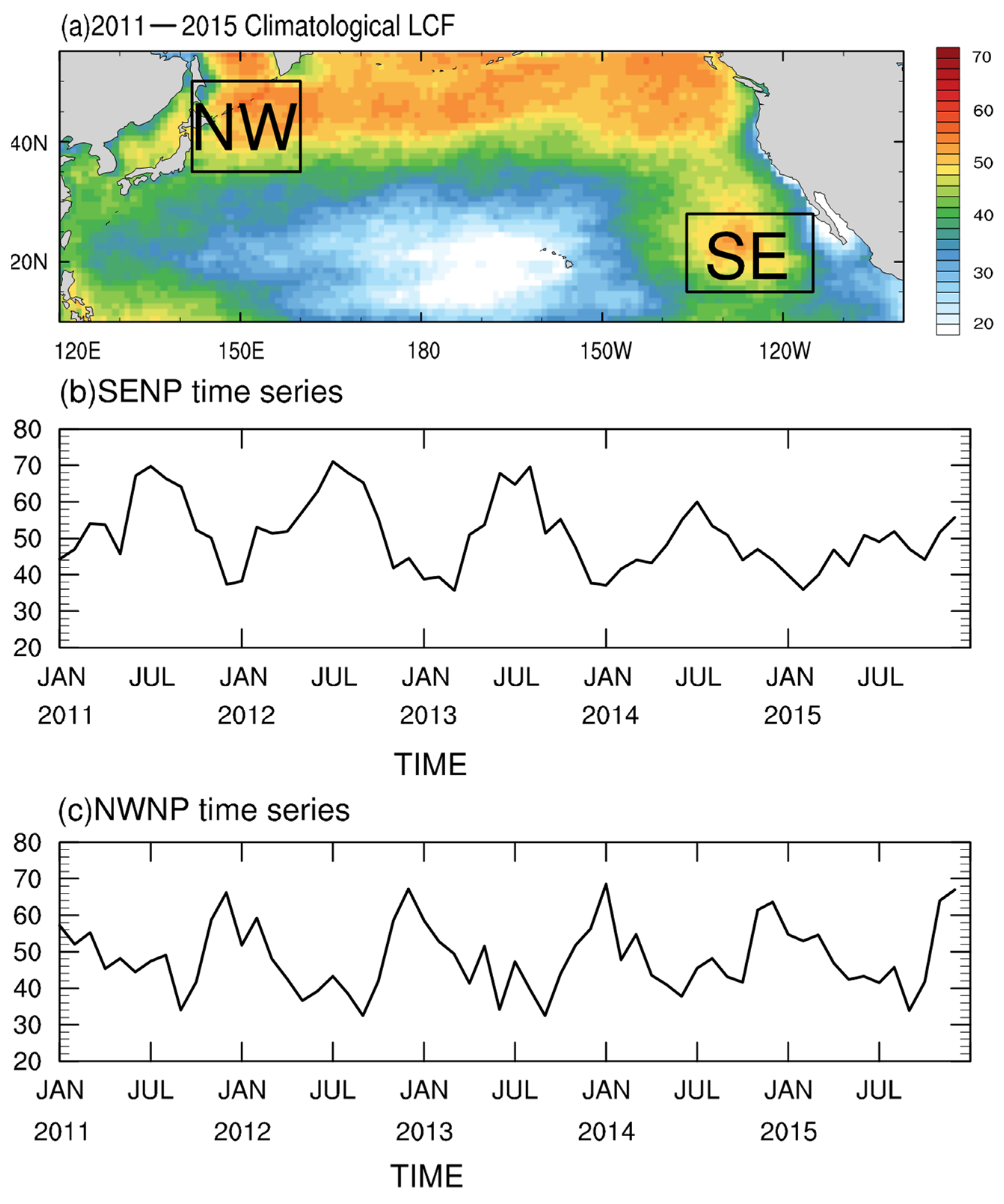
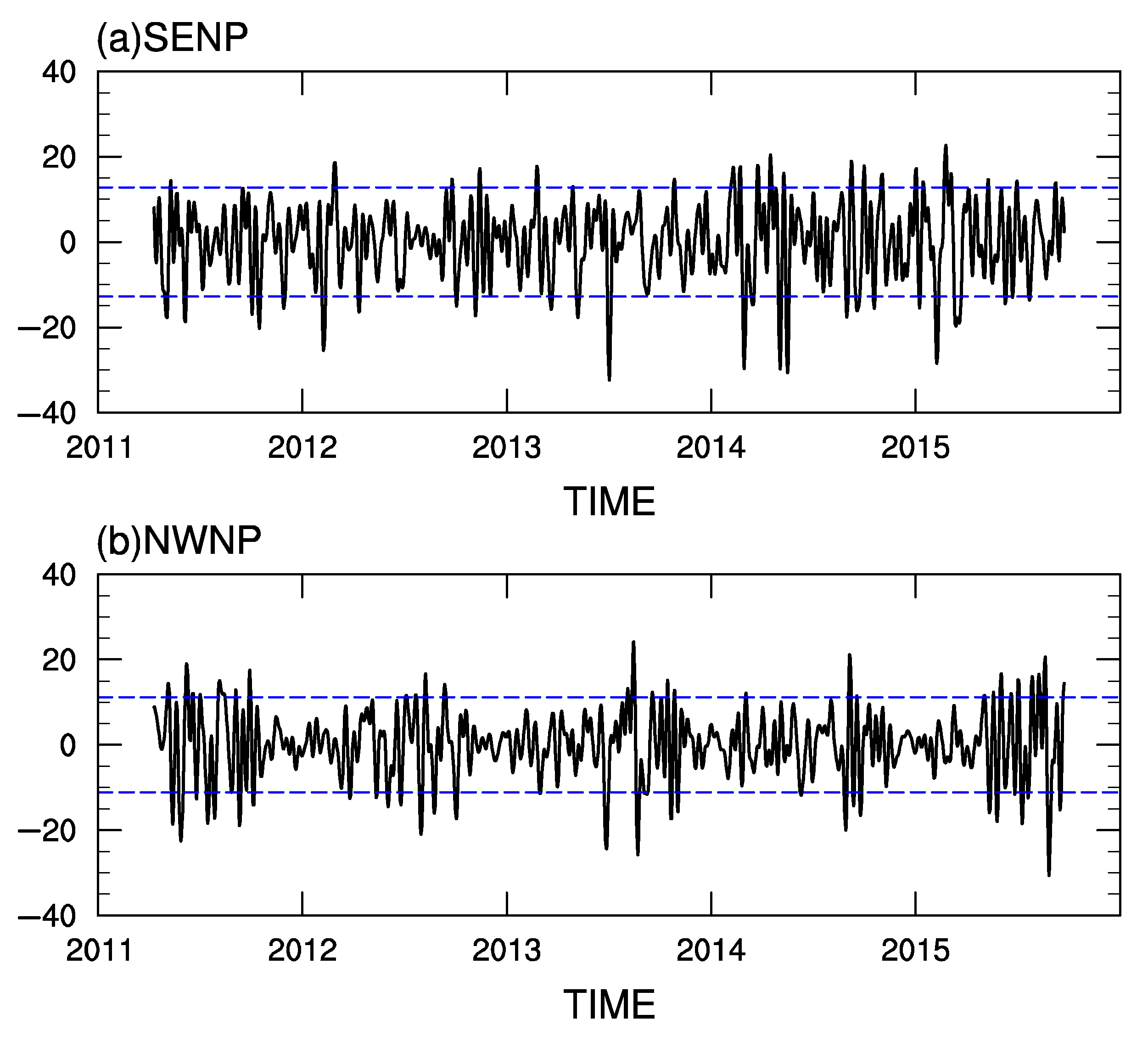
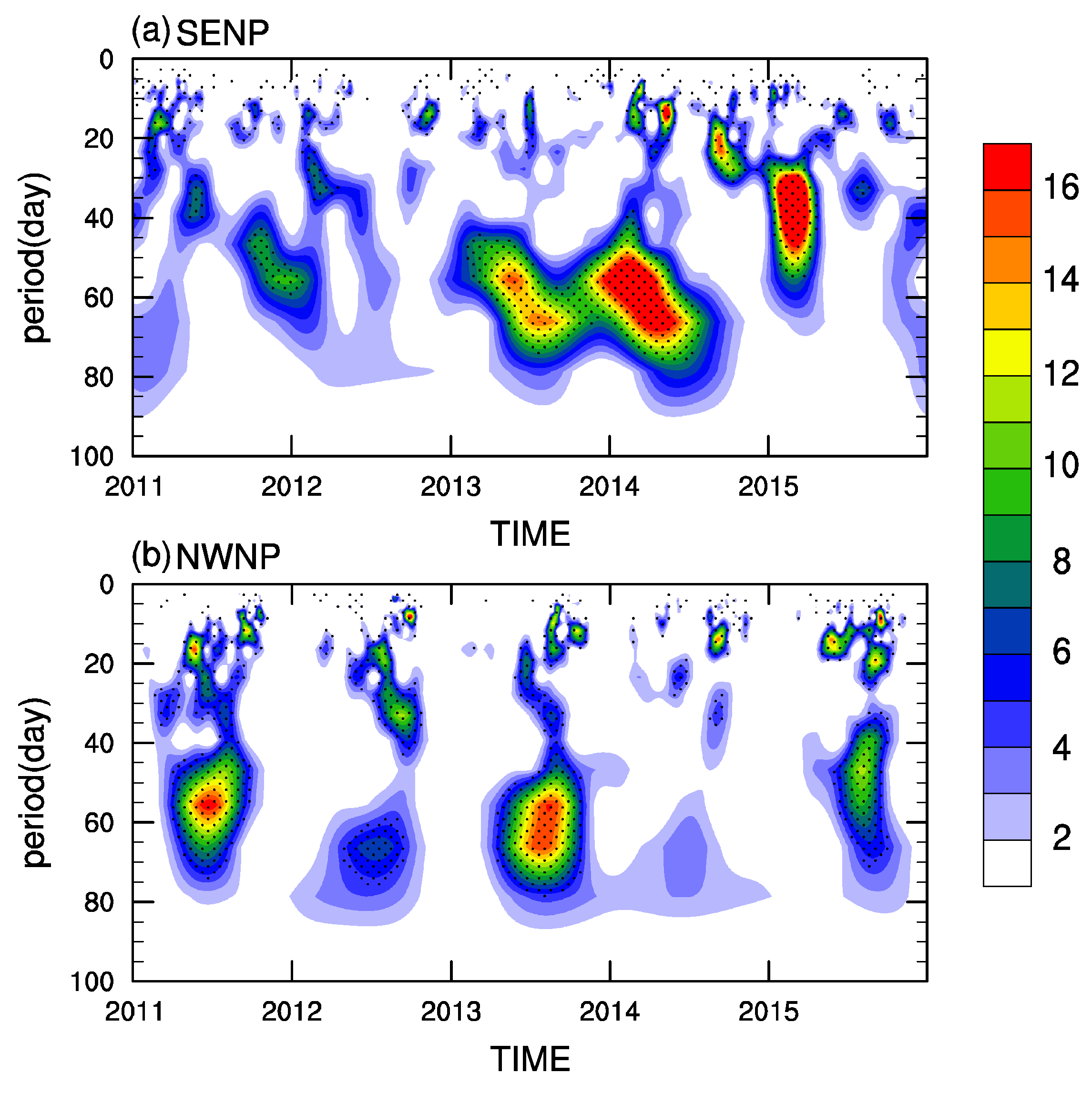

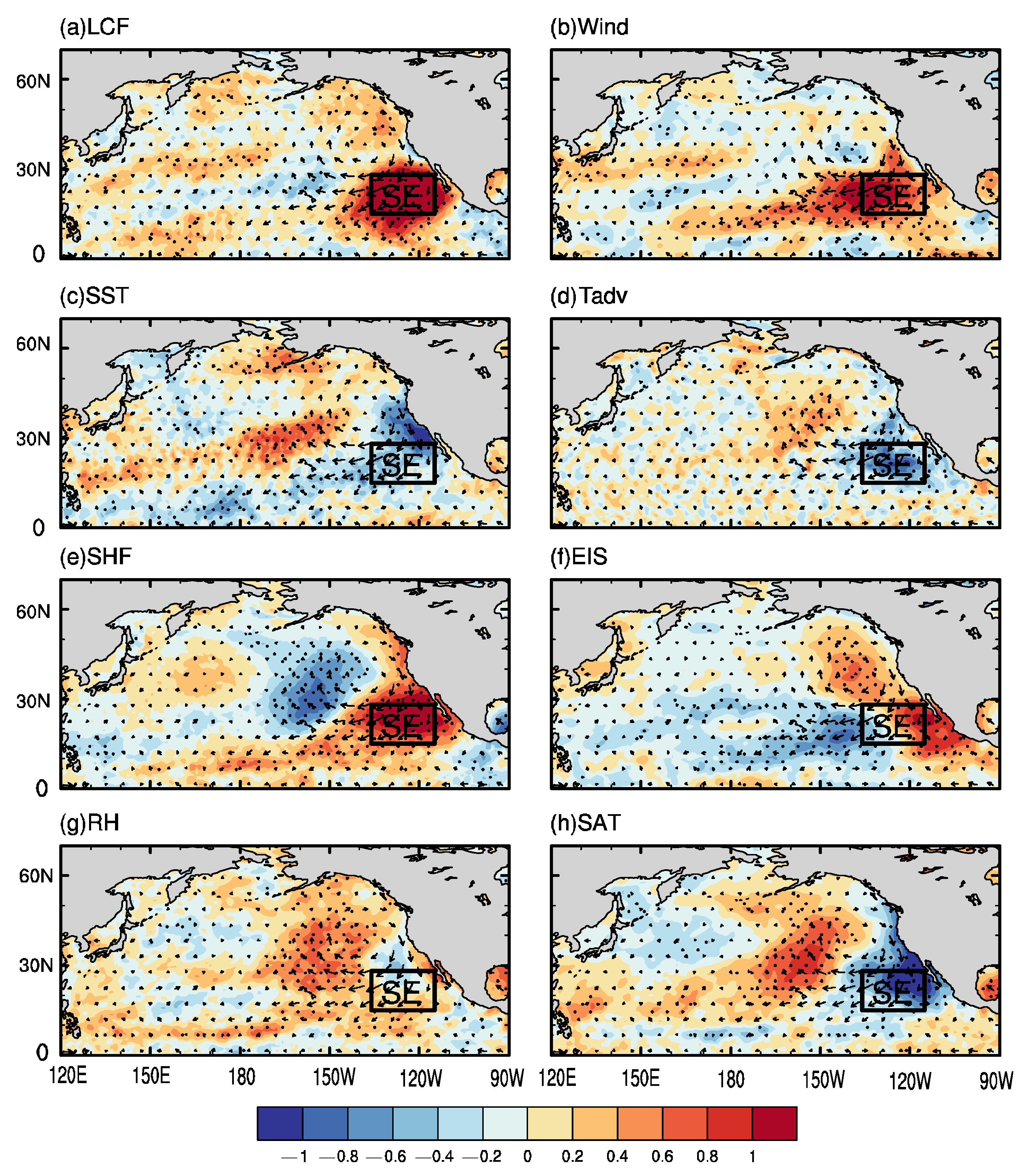
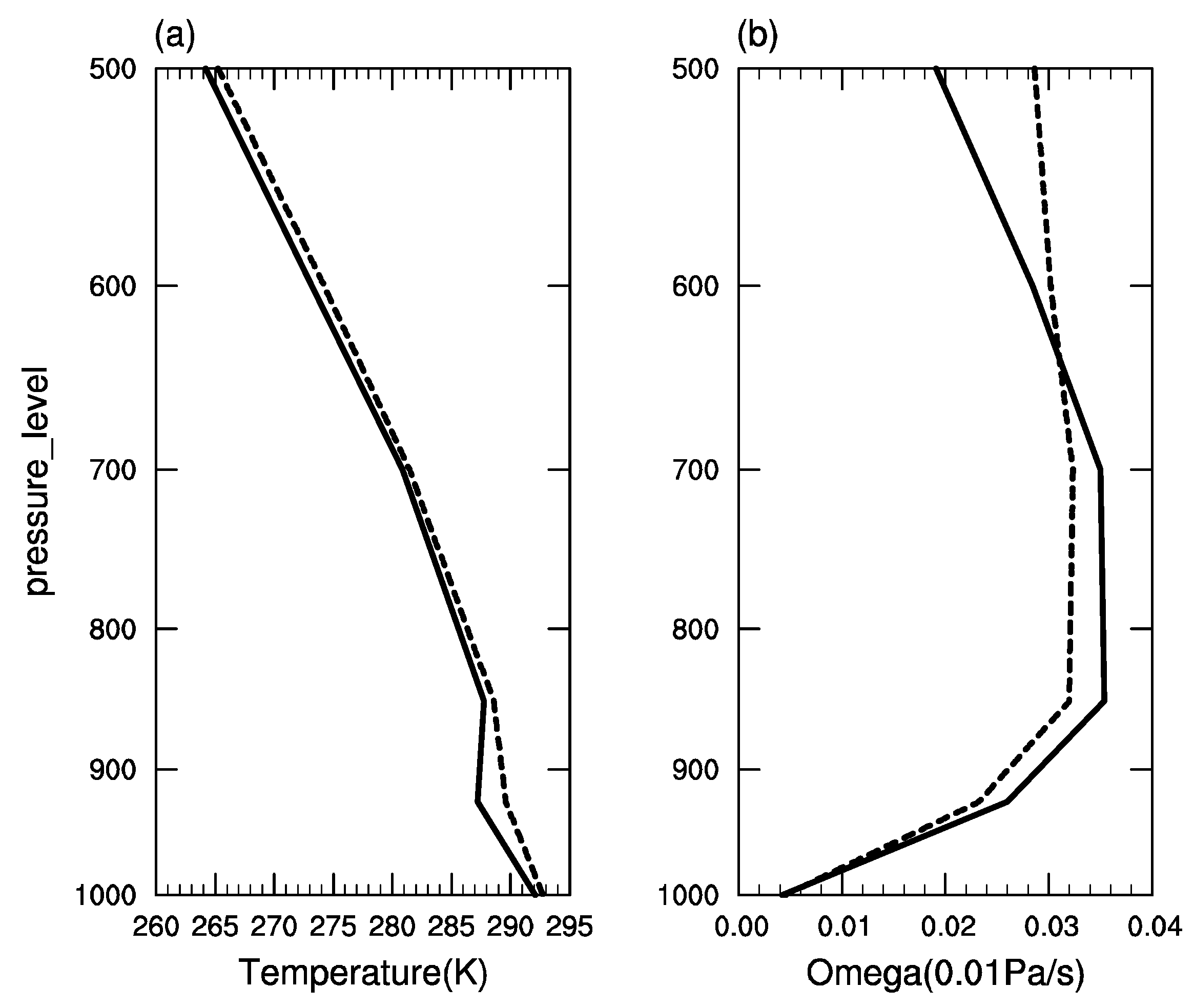

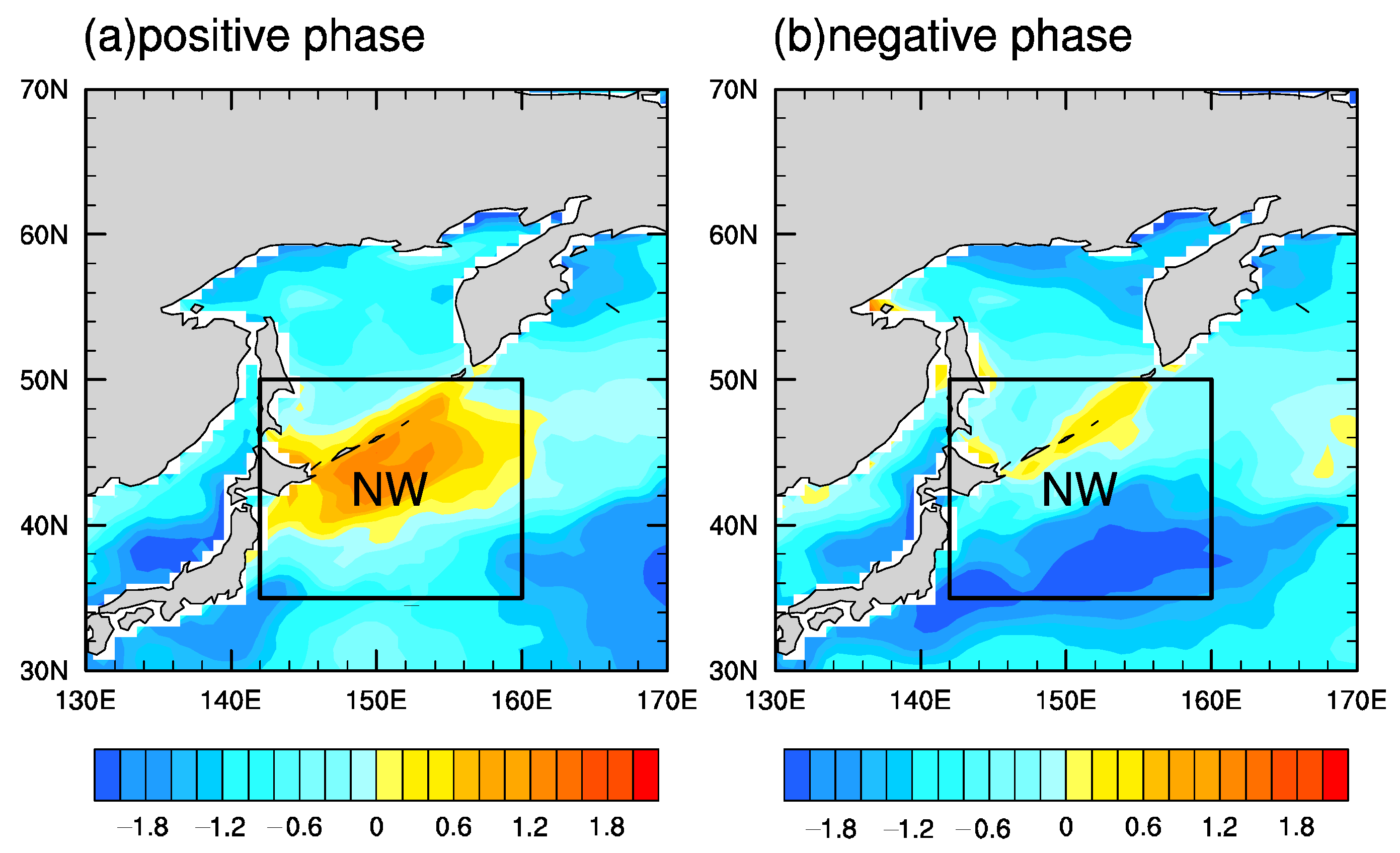
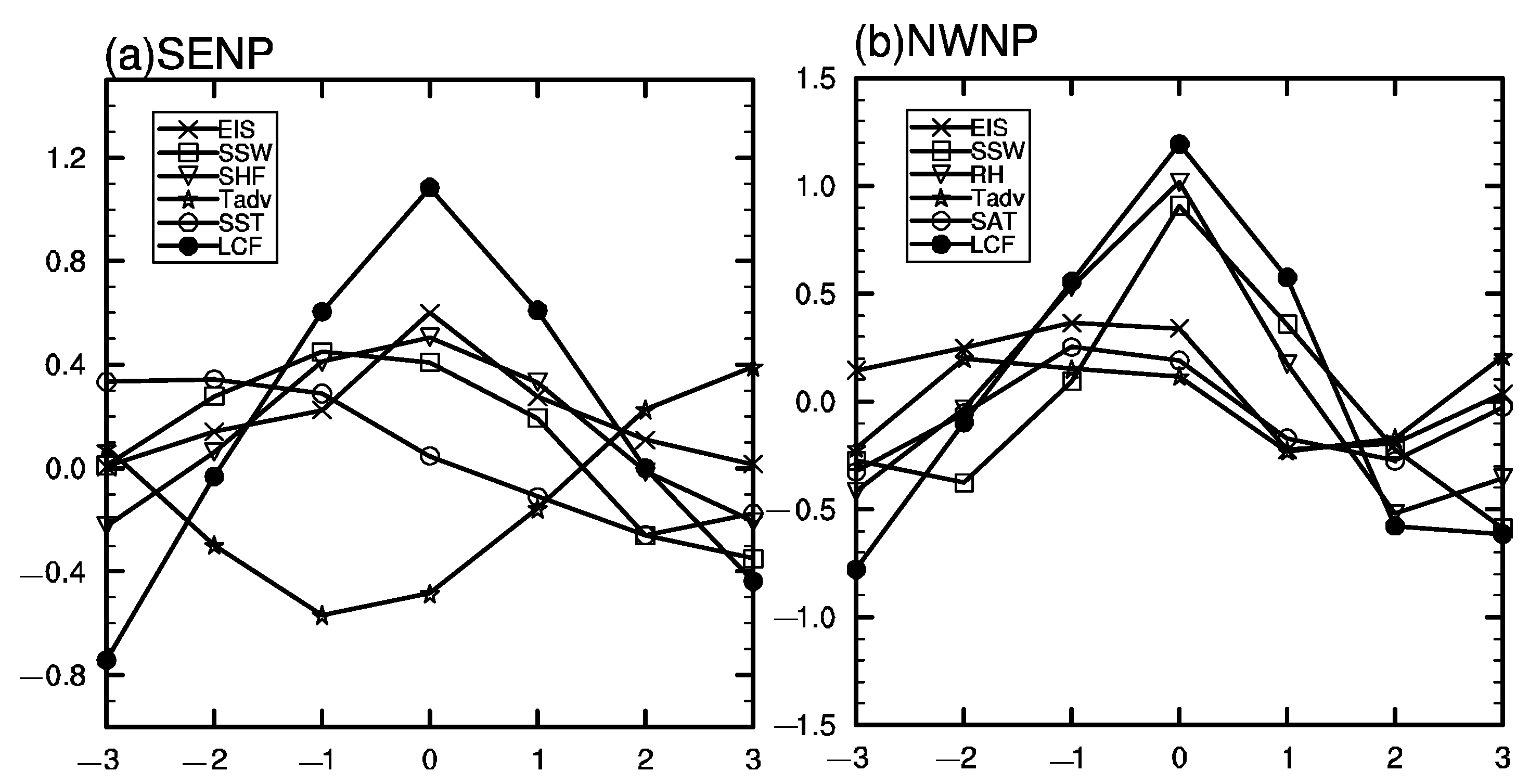
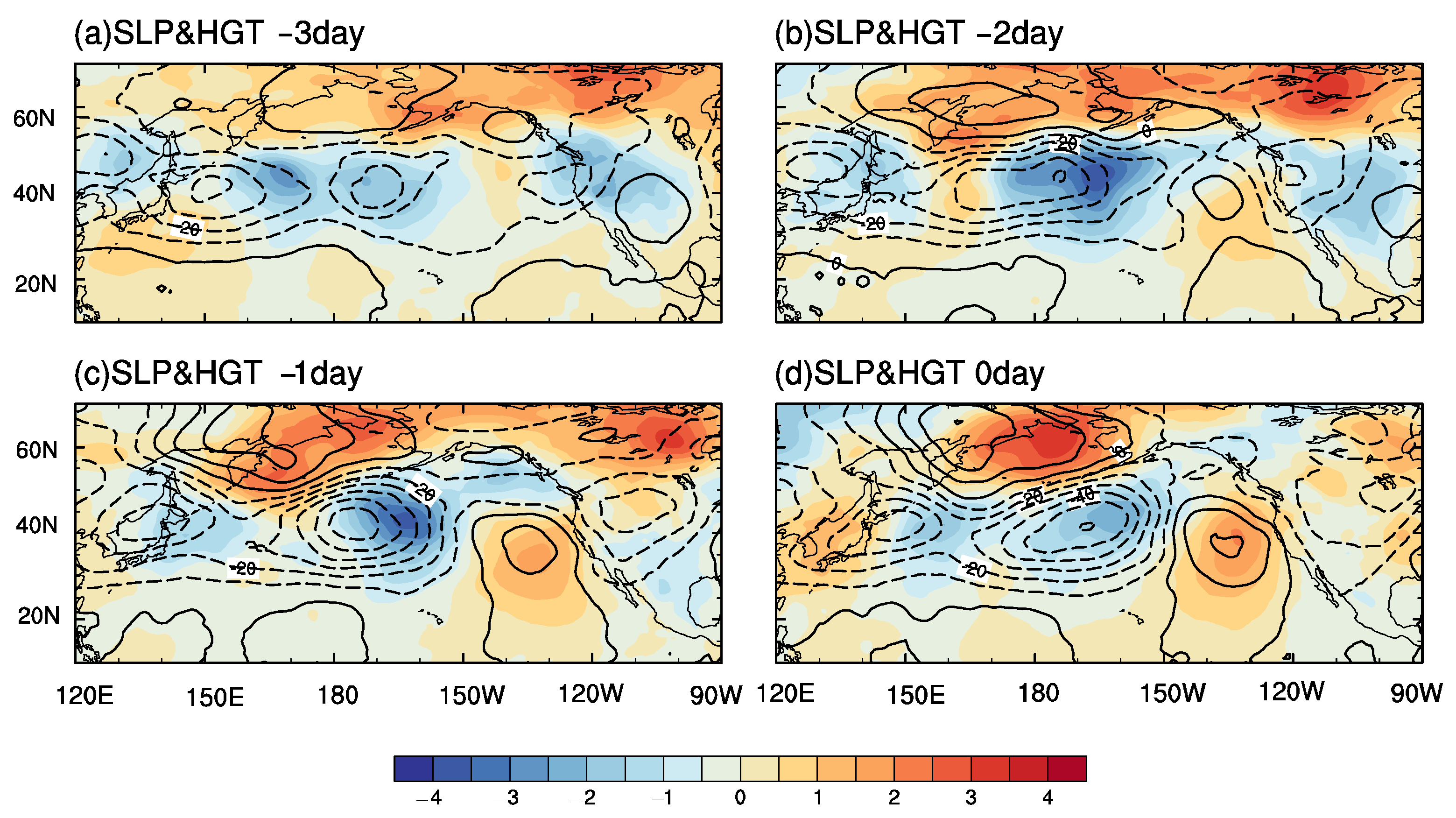

Disclaimer/Publisher’s Note: The statements, opinions and data contained in all publications are solely those of the individual author(s) and contributor(s) and not of MDPI and/or the editor(s). MDPI and/or the editor(s) disclaim responsibility for any injury to people or property resulting from any ideas, methods, instructions or products referred to in the content. |
© 2023 by the authors. Licensee MDPI, Basel, Switzerland. This article is an open access article distributed under the terms and conditions of the Creative Commons Attribution (CC BY) license (https://creativecommons.org/licenses/by/4.0/).
Share and Cite
Wang, Q.; Xu, H.; Ma, J.; Deng, J. Subseasonal Variation Characteristics of Low-Cloud Fraction in Southeastern and Northwestern North Pacific. Atmosphere 2023, 14, 1668. https://doi.org/10.3390/atmos14111668
Wang Q, Xu H, Ma J, Deng J. Subseasonal Variation Characteristics of Low-Cloud Fraction in Southeastern and Northwestern North Pacific. Atmosphere. 2023; 14(11):1668. https://doi.org/10.3390/atmos14111668
Chicago/Turabian StyleWang, Qian, Haiming Xu, Jing Ma, and Jiechun Deng. 2023. "Subseasonal Variation Characteristics of Low-Cloud Fraction in Southeastern and Northwestern North Pacific" Atmosphere 14, no. 11: 1668. https://doi.org/10.3390/atmos14111668
APA StyleWang, Q., Xu, H., Ma, J., & Deng, J. (2023). Subseasonal Variation Characteristics of Low-Cloud Fraction in Southeastern and Northwestern North Pacific. Atmosphere, 14(11), 1668. https://doi.org/10.3390/atmos14111668





